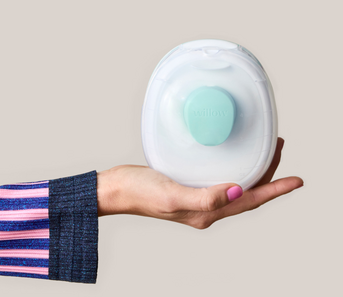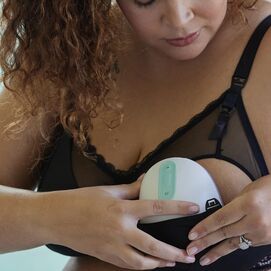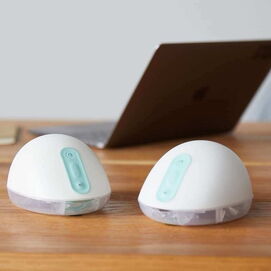We’ve all been there —you can feel the tingle and heaviness of an overly full breast, so you reach for your pump to get some relief. But then, your breast pump isn’t full of milk. What’s going on?
This is a common issue for many breastfeeding moms and even though it’s frustrating and painful at times, difficult pumping can be fixed. Let’s dive into the reasons why the milk isn’t flowing and what you might be able to do about it.
4 Reasons Your Breasts May Feel Full, But There’s No Milk When Pumping
Do you feel like you might topple over from the weight of your breasts? Trying to pump only to see a couple of drops in the bottle? There are three common reasons mamas experience a feeling of fullness without any yield.
Your Milk Hasn’t Come in Yet
If you’re trying to pump right after giving birth, it’s possible that your milk hasn’t come to volume yet. According to the CDC, most moms won’t see actualbreast milk until 3 days after birth. Itmay take even longer for some moms.
The first substance your breasts make is colostrum, which is thick and yellowish. Colostrum is a concentrated form of breast milk, which delivers all the immuniological protection and nutrients your baby needs for their first few days of life.
Pumping colostrum won’t yield as much liquid as your transitional or mature breast milk. In fact, you can expect to see only a teaspoon or less per expression, even though your breasts feel full due to the enlargement of blood vessels after birth.
Warm compresses and gentle massage will improve comfort and skin to skin time with your baby as well as frequent nursing sessions will help your breast trasition from colostrum to flowing milk.
You’re Struggling With Letdown
Letdown is a reflex that results in milk being released from your breast. Stimulation causes the release of the hormone oxytocin which then signals your breast milk to start flowing. Normally, your baby’s sucking will be all the stimulation that’s required.
Some mamas struggle with letdown due to stress, sleeplessness, anxiety or pain. The truth is, on some days, letdown is just hard. Without letdown, you won’t be able to pump very much milk at all, even though your breasts feel full.
What can you do about it? Here are some tips to improve your letdown reflex:
Keep your baby close: Oxytocin is released when you see or think about your baby. Snuggle your baby close to you and take in all the cuddles. If you’re away from your baby, watch a video you’ve captured of them on your phone or look at a photo.
Take a warm shower or bath: If you’re able, taking a warm shower or bath can help you relax your body enough for letdown to do its thing. Or, if you can't do that, try closing your eyes and taking a few deep breaths.
Massage your breasts: Before you pump, gently massage your breasts to mimic the stimulation that typically comes from your baby. This can help release oxytocin as well.
Mastitis
If your breasts are feeling heavy, tender to the touch and swollen, you may have mastitis, which is common for breastfeeding moms. Mastitis is inflammation of the breast tissue and can lead to pain and a burning sensation when pumping which can affect the amount of milk you express.
If you believe you may have mastitis, go ahead and call your doctor. They may be able to prescribe some antibiotics or give you some tips on how to relieve your symptoms. And yes, it is safe to continue pumping or breastfeeding your baby with mastitis.
Your Milk Supply Is Low
Another issue mamas might struggle with is low milk supply. This can result in you pumping and hand expressing yet not producing much milk. And when your breasts feel more full after birth, milk supply can be misleading.
Causes of Low Breast Milk Supply
What causes low breast milk supply? Some mamas simply don’t make as much milk as others. Yet, this is rare. According to the Mayo Clinic, most women make one-third more breast milk than their babies typically drink. The strongest predictor of a robust milk supply is routine breast emptying for the first two weeks post delivery, this means breastfeed or pump at least every 3 hour for the first 14 days to assure your best supply.
Yet, dips in your milk supply can happen. Some of the causes of low milk supply include:
-
Underlying medical conditions: Your breast milk supply can be affected by stress, hypothyroidism, polycystic ovarian syndrome (PCOS), a difficult birth and illness. If you feel concerned about your health and your milk supply, it’s best to reach out to your doctor for advice.
-
Poor latch: If your baby isn’t latching onto your breast the right way, they may not be removing enough milk. And as your body uses your baby’s feeding patterns to determine how much milk to make, this can reduce your supply. This can also apply to an improperly fitting flange. Nipple sizes generally shrink over time, consider remeasuring if you see a decline in pumping volume.
-
Not breastfeeding or pumping enough: The more milk you express, the more milk your body will make. If you’re not pumping between breastfeeding sessions or allowing your baby to go more than 2-3 hours without breastfeeding, this can affect your supply.
-
Baby growth spurts: Growth spurts are your baby’s way of preparing your body to make more liquid gold. Typically, babies will feed more often during a growth spurt, which might lead you to believe your supply is low when it isn’t.
The Perfect Fit Bundle
The Perfect Fit Bundle
Need extra sizing support? Get a set of four inserts (they help create a more snug flange fit), access to a Sizing Specialist for 1:1 guidance, and more.
What You Can Do About Low Milk Supply
Are you struggling with low milk supply? We know it can be overwhelming, especially when you want so badly to feed your baby through breastfeeding and pumping. The good news is there are some great methods you can try to boost your milk supply.
-
Pumping Can Increase Your Milk Supply
Simply increasing the number of times you pump in a day can help increase your milk supply. For example, you can simply pump between breastfeeding sessions to try and stimulate milk production. Or, you can try power pumping, which means pumping every five minutes for an hour or so.
-
Use a Heating Pad or Take a Warm Shower Before Expressing Milk
Heat increases circulation. That’s why we use heating pads on sore muscles after arm day at the gym. Yet, this also works for breastfeeding. Increased blood circulation to the breasts can help improve the flow of your milk and may result in more milk expressed during a pumping session.
Try placing a warm heating pad on your breasts before pumping. Or, make time for a nice warm shower or bath. This also helps relax you which can help with your letdown reflex.
-
Massage Your Breast Area & Try to Hand Express Your Milk
A quick breast massage can help open your milk ducts and release oxytocin for letdown. Then, try hand expressing your breast milk. Hand expression can often lead to more milk yield than pumping alone. And the more milk you can get from your breast, the more your body will make.
-
Eat Breastfeeding Superfoods
What you eat can definitely fuel how much milk you’re able to produce. According to the Mayo Clinic, breastfeeding moms should choose protein-rich foods that boost milk production, including lean meat, eggs, dairy, beans, lentils and seafood low in mercury. You should also eat plenty of whole grains and vegetables.
This article was written in partnership with our International Board Certified Lactation Consultant, Wendy Wright, who loves working side by side with moms and babies to find that secret sauce! She’s also a mother of two and the Mom Experience Lead at Willow Pump.
Get pumping support with Simplifed
Get pumping support with Simplifed
Get access to free virtual feeding support from the lactation consultants at Simplifed. They can help you navigate supply issues, introduce a bottle, and more, and are trained on Willow pumps.















